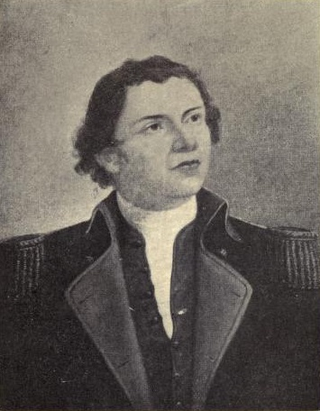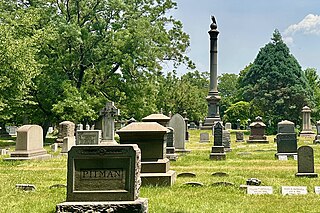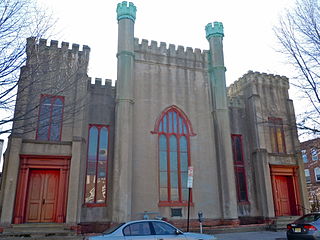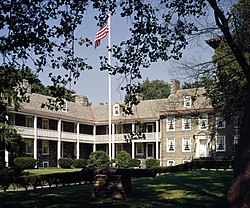
Trenton is the capital city of the U.S. state of New Jersey and the seat of Mercer County. It was the capital of the United States from November 1 until December 24, 1784. Trenton and Princeton are the two principal cities of the Trenton–Princeton metropolitan statistical area, which encompasses those cities and all of Mercer County for statistical purposes and constitutes part of the New York combined statistical area by the U.S. Census Bureau. However, Trenton directly borders the Philadelphia metropolitan area to its west, and the city was part of the Philadelphia combined statistical area from 1990 until 2000.

Washington Crossing State Park is a 3,575-acre (14 km2) New Jersey state park that is part of Washington's Crossing, a U.S. National Historic Landmark area. It is located in the Washington Crossing and Titusville sections of Hopewell Township in Mercer County, north of Trenton along the Delaware River. The park is operated and maintained by the New Jersey Division of Parks and Forestry. It is supported by the Washington Crossing Park Association, a friends group that works to preserve, enhance, and advocate for the park.

Hugh Mercer was a brigadier general in the Continental Army during the American Revolutionary War. He fought in the New York and New Jersey campaign and was mortally wounded at the Battle of Princeton.

Washington Crossing Historic Park is a 500-acre (2 km2) state park operated by the Pennsylvania Department of Conservation and Natural Resources in partnership with the Friends of Washington Crossing Park. The park is divided into two sections. One section of the park, the "lower park," is headquartered in the village of Washington Crossing located in Upper Makefield Township in Bucks County, Pennsylvania. It marks the location of George Washington's crossing of the Delaware River during the American Revolutionary War.

Fort Lee Historic Park is located atop a bluff of the Hudson Palisades overlooking Burdett's Landing, known as Mount Constitution, in Fort Lee, New Jersey, United States. The park was conceived as early as 1952.

The Indian King Tavern was a colonial American tavern in Haddonfield, Camden County, New Jersey, United States, which was the site of a 1777 meeting of the New Jersey Legislature adopted its Great Seal. It was the first State Historic Site, adopted as such in 1903. Its original structure remains largely intact. It is listed on the National Register of Historic Places.

Riverview Cemetery is a historic cemetery located at 870 Centre Street in the city of Trenton, New Jersey in Mercer County, New Jersey, United States. A number of notables are interred there, including Civil War Union Army Major General and New Jersey Governor George B. McClellan, whose grave is marked by the tallest monument in the cemetery. His wife, Mary Ellen Marcy McClellan, is interred with him.

Established in 1703, St. Michael's Church in downtown Trenton, Mercer County, New Jersey, United States, is a founding parish of the Episcopal Diocese of New Jersey. Its present building located at 140 North Warren Street was built in 1747–1748, and was renovated in 1810 and 1847–1848. It was listed on the National Register of Historic Places on April 29, 1982 as St. Michael's Episcopal Church.

The Princeton Battlefield in Princeton, Mercer County, New Jersey, United States, is where American and British troops fought each other on January 3, 1777, in the Battle of Princeton during the American Revolutionary War. The battle ended when the British soldiers in Nassau Hall surrendered. This success, following those at the Battle of Trenton on December 26, 1776, and the Battle of the Assunpink Creek the day before, helped improve American morale.

The William Trent House is a historic building located at 15 Market Street in Trenton, Mercer County, New Jersey. It was built in 1719 for William Trent and is the oldest building in Trenton. He founded the eponymous town, which became the capital of New Jersey. It has served as the residence for three Governors. The house was added to the National Register of Historic Places and listed as a National Historic Landmark on April 15, 1970, for its significance as an example of Early Georgian Colonial architecture.

The Red Bank Battlefield is located along the Delaware River in National Park, Gloucester County, New Jersey. It was the location of the Battle of Red Bank in the American Revolutionary War on October 22, 1777. Fort Mercer and its sister, Fort Mifflin in Pennsylvania, defended the river and prevented the British from using it for transportation. The forts successfully delayed the British, but in the end, they were both destroyed or abandoned.

The Trenton Battle Monument is a massive column-type structure in the Battle Monument section of Trenton, Mercer County, New Jersey, United States. It commemorates the December 26, 1776, Battle of Trenton, a pivotal victory for the Continental forces and commander George Washington during the American Revolutionary War.

First Presbyterian Church is a historic church located at 120 East State Street in Trenton, Mercer County, New Jersey, United States. The church's first congregation got together in 1712 and their first church was built in 1726. The church building and churchyard cemetery were added to the National Register of Historic Places for their significance in architecture, politics, religion, and social history on September 9, 2005.

The Douglass House is a historic house currently located at the corner of Front and Montgomery Streets in the Mill Hill neighborhood of the city Trenton in Mercer County, New Jersey. It served as George Washington's headquarters prior to the Battle of Princeton on January 3, 1777. Listed as the Bright–Douglass House, it was documented by the Historic American Buildings Survey in 1936, when the house was located in Mahlon Stacy Park near the Delaware River. It was added to the National Register of Historic Places on December 18, 1970, for its significance in architecture, military and social history. It was added as a contributing property to the Mill Hill Historic District on December 12, 1977.

Gen. Philemon Dickinson House is located in Trenton, Mercer County, New Jersey, United States.

The Old Masonic Temple in Trenton, Mercer County, New Jersey, United States, is a historic building built in 1793 at the corner of Front and Willow streets near the New Jersey State House, and across the street from the Old Barracks. In 1915 when a new building was constructed for the Trenton Lodge, the old building was moved half a block south to 102 Barrack Street. It has served as a Masonic Lodge, a school, a shop for a furnisher and upholsterer, a museum, and is now a tourist information center. In 1970 the building became part of the State House Historic District listed by the National Register of Historic Places.

The Isaac Watson House is the headquarters of the New Jersey State Society of the National Society of the Daughters of the American Revolution (DAR). It is located just outside the state capital of Trenton in Hamilton Township, Mercer County, New Jersey. It is situated on a bluff overlooking Watson's Creek and the Abbott Farm National Historic Landmark in John A. Roebling Park, a 257-acre nature preserve.

The State House Historic District encompasses many historic buildings along West State and Willow Streets in Trenton, New Jersey, including the New Jersey State House, Old Barracks Museum, and the Old Masonic Temple.

The John Abbott II House is located at 2200 Kuser Road in Hamilton Township of Mercer County, New Jersey. It was built c. 1730. The house is currently used as a museum by the Historical Society of Hamilton Township and is open to the public. It was added to the National Register of Historic Places on June 18, 1976, for its significance in architecture, military history, and politics/government.

The Jeremiah Woolsey House is a historic Dutch Colonial home located at 237 Washington Crossing–Pennington Road, southwest of Pennington, in Hopewell Township of Mercer County, New Jersey. Listed as the Jeremiah M. Woolsey House, it was documented by the Historic American Buildings Survey in 1936. The house was added to the National Register of Historic Places on January 27, 1975, for its significance in architecture and politics/government.



























